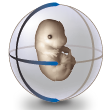Image Processing - Method 3
Protocol
3D Reconstruction from sections
Histology sections were captured as digital images in one of the configurations described in Image Capture Summary
A pair-wise neighbourhood rigid-body registration through the stack of histology sections is done to recover the first-order approximation of the z-coordinate information.
A template, combining the OPT reconstruction of the embryo and the "real" shape before sectioning, is built by identifying key sections between histology and OPT, and by interpolating the correspondence of non-key sections between.
Affine registration is established from pair-wise tie-pointing the key sections, followed by automatically propagating tie-points through the block of neighbours. The affine transform is applied to the histology to build an almost correct reconstruction where global deformation has been recovered.
Local deformation correction is done by automatically extracting feature points from key section, tracking the points down through the stack to establish feature-point trajectory, and smoothing the trajectory. Deformable transformations, built from the feature-point trajectory and the smoothed ones, is used to transform the sections.
The deformed sections are stacked up to construct a 3D model.
The completed models can be viewed using the EMA stage selector.




